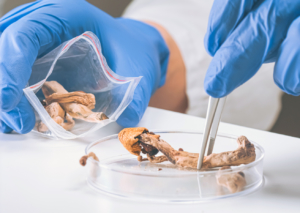
Humans have written a lot about what we see and experience on psychedelics: mischievous spirits, stereotypical melting faces, even feeling like “a butterfly in a wet suit.” But what about animals that eat psychedelics?
What does a moose see after a heroic dose of mushrooms? What about a jaguar enjoying ayahuasca as an aperitif? Do they see their ancestors? Their birth?
Their inevitable death? Mr. Peanut holding an IV?
We can only wonder.
Some species find themselves intoxicated in the wild more than you might expect — and many go straight for the most bizarre sh*t on the shelf.
Here are animals who enjoy a little bit of psychedelic strange every now and again to take their brains on a sojourn above the stratosphere.
Reindeer Eating Psychedelic Mushrooms
Many categories of deer dine on psychedelic mushrooms, including reindeer, moose, and caribou.
While foraging, the deer will sniff out fly agaric (Amanita muscaria) mushrooms frozen beneath winter snow. These red and white-flecked shrooms are closely related to deadly varieties like the aptly-named destroying angel and death cap. However, while they boast their own collection of toxins, they’re not harmful like their other agaric counterparts.
They contain muscimol, a compound that induces a sedative and hallucinogenic effect in mammals. Humans (like the Siberian tribal societies who drink the psychoactive urine of agaric-eating reindeer) report a dream-like state under the influence.
Observers report that after eating the fungi, deer often act drunk by running around aimlessly, twitching their heads, and making noises.
Eating these mushrooms infuses the caribou’s urine with psychoactive agents, meaning that the urine can, and is, consumed for a high. Caribou will battle each other to earn access to the urine of a herd mate that has fly agaric in its system. In noticing this, Siberian tribes realized that they too could benefit from drinking this spiked caribou urine.
After passing through the reindeer’s system, the psychoactive agents of the fly agaric are even stronger with the added benefit of the chemicals that cause undesirable side effects being filtered out. Any species, whether deer or human, that drinks the psychedelic pee will experience a more potent high than the original shroom-muncher.
Jaguars on Yagé
Jaguars are the largest cats in the Americas, roaming everywhere from Southern Arizona to the warmer pockets of South America. While they usually take their role as an apex predator seriously and stalk around confidently as a cunning mass of muscles, teeth, and claws — they also like to party.
From time to time, jaguars will munch on the leaves of the yagé vine (Banisteriopsis caapi for all you botanists out there). The vine grows abundantly in the Amazon Rainforest and takes jaguars from intimidating to delightfully intoxicated. Perhaps you’ve seen this clip of a jaguar acting like a big, tipsy, goofy kitten from BBC’s Weird Nature.
Humans have also been known to enjoy a Banisteriopsis caapi cocktail now and again: the vine is the primary component in ayahuasca, a psychedelic spiritual aid used by both indigenous Amazon people and a slew of celebrities.
Ayahuasca is most known for containing the hallucinogen DMT, but contrary to popular belief, that ingredient doesn’t come from yagé. Instead, the harmala alkaloid compounds from the vine make the DMT from another ayahuasca ingredient orally active. Because of this, the jaguars are more likely tripping on harmala alkaloids that, while intense, are probably not comparable to the effects of a full ayahuasca cocktail.
Scientists don’t have a solid hypothesis why jaguars drug themselves like this (I’m no scientist, but I think the video makes it pretty clear that they enjoy it). However, some South American tribes believe the effects of the vine improve hunting skills in animals. Experts also don’t know the exact effects on the big cat’s brain, but any observer can conclude that if it’s enough to make a jaguar wriggle on its back and stare at trees with intense fascination, it must be pretty powerful.
Primates and Performance-Enhancing Psychedlics

Iboga (Tabernanthe iboga) is a shrub native to the tropical rainforests of Central Africa. Aside from bearing long, bright orange fruit, it contains ibogaine: an often overlooked psychedelic compound. Ibogaine is most concentrated in the roots and bark of the iboga, and many different types of wildlife are known to indulge in its effects. But of these many species, one, in particular, appears to use it for premeditated purposes.
Mandrills — a more colorful cousin of baboons — in Gabon and the Congo are believed to use Iboga roots as a performance-enhancer in dominance conflicts.
In his book Animals and Psychedelics, Italian ethnobotanist Giorgio Samorini narrates a conversation with a Mitsogho shaman in Gabon. The shaman describes how male mandrills, which routinely compete for dominance over their meandering bands, use iboga root to hype themselves for competition.
According to the shaman, the primates seek out iboga, pluck it from the ground, eat the roots, wait for their high to settle in, then prepare for battle. It’s unclear what performance-enhancing benefits they’re experiencing, but it’s possible that the psychedelic could induce a pain-killing effect and improve reaction time.
Monkeys, Lemurs, and Bighorn Sheep: Other Examples

The three above are only a small sampling of potential animals that eat psychedelics. It’s often cited that bighorn sheep pursue impossible-to-reach psychedelic lichen off the Canadian Rockies to get that “Rocky Mountain high.”
Moreover, lemurs and other types of monkeys rub toxic millipedes on their bodies to apply a mosquito-killing pesticide. They also nibble on the millipede, which appears to give them a little high. Whether that high is hallucinogenic or not is unclear.
But, what is clear is that the animal kingdom certainly has its fair share of fascination with altered states and “chasing the dragon,” proving once again that humans aren’t as unique as we often like to think.





